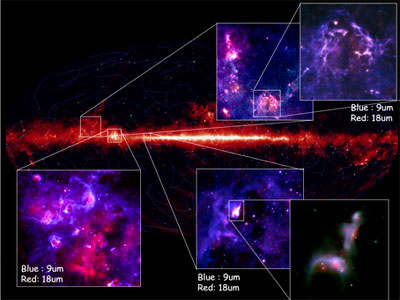Infrared astronomy group
"Infrared" light is the electromagnetic wave at the wavelength of approximately 1 micron to a few 100 micron. Our laboratory is pursuing astronomical observations by looking into the Universe in infrared light utilizing space and balloon-borne telescopes. One advantage of infrared observations is that we can actually look into the astronomical objects that are not observable in visible, optical light. Small (<~0.1 micron) solid particles called as "dust" in the space obscure the visible light from astronomical objects. For example, you can see a dark lane toward the center of the Milky Way (toward Sagittarius) when you gaze up the night sky. However, the dust itself emits the infrared light, and by examinig this invisible radiation, we can understand what kind of material exist in what kind of physical environment in the Universe.

Figure 1 shows the all-sky map of our Milky Way galaxy obtained with "AKARI" infrared satellite, showing the thermal emission from dust grains in the galactic plane. This "dust" plays a critical role in producing organic, pre-biotic material, rocky planets like the Earth, and evolution of galaxies in the Universe. Therefore, it is central to understand how dust grains form and evolve both physically and chemically in order to address the key big question: "How has the Universe evolved and yielded the present-day diversity of astronomical objects, including life like us?". However, infrared light in a relatively wide wavelength range is absorbed by the Earth's atmosphere, and hence observations from the ground is sometimes too challenging. Launching space telescopes is a solution for this problem, although it is required to cool down the telescope and instruments to the temperature below ~10 kelvin to suppress the thermal infrared emission from the telescope and instruments themselves, which contaminates the signal from the astronomical objects. Our laboratory, together with JAXA and University of Tokyo, developed the ultra cool telescope and the infrared instruments, then successfully launched the infrared astronomical satellite "AKARI" in 2006 (Figure 2).

Fig. 2 : Launch of "AKARI" satellite(February in 2006)
Space infrared astronomy is the wild frontier associated with many technical challenges, and further progress is surely expected in future. Our laboratory has an important role in the (yet small) community of space infrared astronomy in Japan.
Education for graduated students
The time scale of one space mission is quite long compared to that of students' PhD or master's course, because a mission requires developing a telescope and instruments as well as a tremendous amount of preparation work to lead the mission to the success. Graduated students thus cannot always observe using the instrument developed by their own. Instead, they can develop instruments for the next-generation space mission, while also carry out scientific research using the on-going mission satellites and/or the data obtained thus far. In our laboratory, students first feel excitements of performing the world's advanced science research using the data taken with AKARI satellite. At the same time, to learn the fundamental technique to achieve infrared space observations, they can participate in development experiments for SPICA, the next generation infrared space observatory. We value the balance between scientific and technological aspects for students to learn astrophysics comprehensively. Also, we give guidance for students to write professional, scientific papers in English in as early stage as possible.